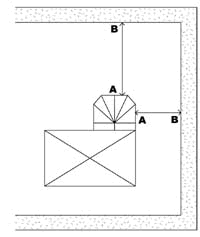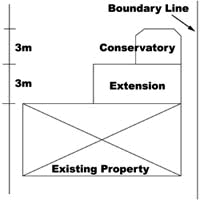| |
|
Detached
Properties |
|
| The
above mentioned only applies to extensions after the 1 July 1948. |
|
|
We have listed some additional information and conditions which attract planning permission: |
|
|
|
|
Sketch
No. 1 |
|
 |
Irrespective
of the size of the conservatory, should the distance between points
A and B be less than 20m planning permission may be required. |
| Shaded Area may be any of the following:
|
|
| Impact onto the Boundary Normally the local planning officer will be looking at the projection of the conservatory i.e. how far it will protrude into the garden, normally they are happy at about 3m projection from the original house. However, should the proposed conservatory extend more than 3m he may not look at it so favourably and ask for it to be reduced in size. The reason for this is so your neighbour does not have to look at a large brick wall more than 3m long. Hence the term impact onto the boundary. To overcome this you may wish to include a facet to your conservatory which may help in some situations. (see sketch 2) This should be done by your supplier as a matter of course. |
|
|
Sketch
No. 2 |
|
 |
You
can see from this sketch that the total impact onto the boundary
is 6m and you could expect the planning office to reject your application. |
If planning permission is not required a letter of lawful development from the council is always a good item to obtain. So should you wish to sell your property in the future, your have proof that you have complied. However, we strongly recommend, if in doubt always ask your local planning officer. You will find they are always very helpful and they will give you the correct advice so no mistakes are made. |
|